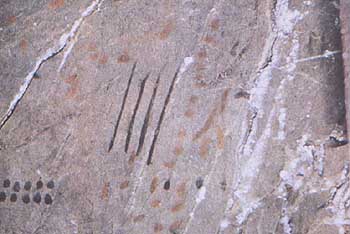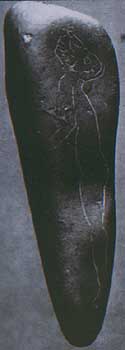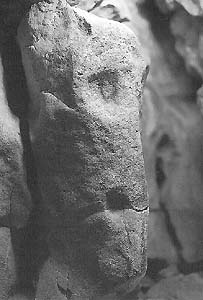Lecture 1 - outline
Probably
a 'shaman' engaged in a ritual dance, dressed as a deer.
This may be an effort to control the animal
by taking on their attributes,even sympathetically,
for mankind depended upon success in the hunt of these creatures.
|
|
Social interpretation: quasi-religious:
'Art of the Hunt' - sympathetic magic or voodoo
Sympathetic
Magic - Wikipedia |
|
|
Types of Images Shown
on Slides :
Simple Markings; 'meander'
drawings (Below):
 from Nauix, France
from Nauix, France |
"Panel Of Signs"
simple markings -
perhaps some symbolic significance,
but the first artistic 'experiments'
probably looked like this.
Paleolithic
Cave Paintings - Boundless.com
|
The first 'finger drawings' were mere playful
experiments
& appear to have no meaning.
Here is a simple line caricature of a generalized
human face -
one writer has described the abstraction as 'grotesque' -
at any rate, it seems probable the cave artists preferred
not to depict people with all the realistic ability at their
disposal. Depictions of people were rare in this time period,
perhaps for fear of accidentally enacting some sort of 'magic'
over themselves.
June, 2008: What
Does the World’s Oldest Art Say About Us? - The
New Yorker
|
|
|
|
|
|
|
Silhouette of the artist's hand -
often found repeated a number of times.
A form of 'signature' or other expression of an independent
ego? This may be so, but more archeologists theorize prehistoric
culture had no real sense of individual identity, certainly
not as we understand the concept.
|
Some dismembered hands appear to be part of
a ritual of some sort, but most appear to be victims of frostbite
in this,
the end of the glacial period.
Notice how the silhouette is created in a 'niche' area of this
outcropping of rock - certain 'areas' seemed to be particularly
inviting for the artist, perhaps for some symbolic or suggested
artistic reason.
|

etchings of animals into stone & bone
(see top of page, right)
depicted here, a rare human subject
|
Sexual
& Magical Pendants

|

natural stone formations suggesting imagery
(see next page)
|
Home | Lecture
2
|